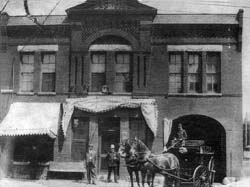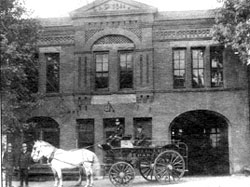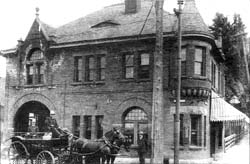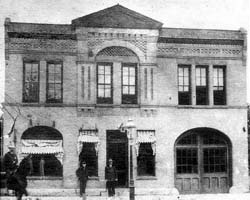In the Beginning — 2
In 1869, Luther H. Eddy, former chief of the Fire Department and city council member for the previous eight years, became chief of police.
The Department continued to grow. On June 5, 1872, a more formal appearance seemed necessary for its nineteen officers and they received their first official uniforms. An appropriation of $116.12 was used to purchase caps, belts, clubs, and badges for these uniforms. Individual officers were required to buy the brass buttoned suits, revolver, and pipe (at that time every “copper” smoked a “cob”). Shortly after the arrival of the uniform, a new rank of sergeant was created.
On November 16, 1874, Saint Paul received another ward. West St. Paul, proclaimed by an act of the legislature as part of Saint Paul, became the sixth ward. This annexation of about 3,000 acres was added to the 10,583 existing acres for a total of 13,583 acres, or twenty-one and one-fifth square miles within the city limits. The city census grew to over thirty thousand residents.
In 1875, the force consisted of twenty-four patrolmen, eight on duty in the daytime and sixteen at night, but later it was increased to thirty men. During this year, the Ramsey County Jail was established as a workhouse for “drunks, disorderlies and vagrants.” While employed on the streets, the “chain gang” (in name only) was supervised by a Saint Paul patrolman.
Despite the growth and improvement of the Department in its first twenty years, crime was still a frequent visitor to the waterfront in the late 1870s. The Mississippi River was the most used mode of transportation for new arrivals to Saint Paul during this time and many ‘less desirable’ citizens were among them. Second Street was the location of numerous low river dives and dance halls. Third Street was a common thoroughfare for theft and violence. ‘Sharpers’ would often lay in wait for the ‘tenderfoot’, in order to relieve him of his money. Saint Paul was known as a “dead-tough town.” No doubt the transient population and the half-lit streets were part of the problem. Even though Saint Paul became known as the toughest town on the river, the police department gained the reputation of being one of the most efficient. The city was patrolled by twenty-four policemen; one-third were on duty during the day and two-thirds at night.
Even though the city population burgeoned tremendously between 1870 and the end of the century, Saint Paul in 1877 was said to be the only city of its size in the United States in which cattle were allowed to roam the streets and trample down yards at will.
In 1879, a workhouse at Como Park was erected to keep habitual vagrants. The first workhouse in Smith Park was a wooden structure surrounded by a pile of stone. Inmates wielded sledgehammers, crushing stone as their menial labor. Men, who were fined and unable to pay the money, were sent to the workhouse to toil away their fines a the rate of $1.00 per day on the pile of stone.
With the flurry of new home construction and the expansion of neighborhoods came sewers, paved streets, and the development of a municipal water system. In order to cope with the changes induced by this growing metropolis, the Department found it necessary to modernize. Modernization encouraged a subsequent raise in salaries. In 1880, the Police Department’s salaries increased to $1,500 for the chief and $1,000 for officers. These salaries remained the same for the next five years, totaling $29,186.79 annually.
The Saint Paul City Hall jail in the early 1880's was, as then Mayor Rice put it, “disgraceful to humanity” and in need of repair. On January 27, 1881, four prisoners escaped by ripping up the floor of the lower corridor and walking out through the cellar. All were caught, but police and city officials deemed the jail “absolutely untrustworthy and not fitted for the purpose of a jail.” Even after much discussion, only minor repairs were done; this state of affairs lasted ten more years.
On June 24, 1881, Louis W. Thomas was appointed to the position of patrolman, the first black patrolman in the history of the Department.
Early in the morning of June 17, 1882, Saint Paul lost its first officer killed in the line-of-duty when newly-appointed Patrolman Daniel O’Connell faced death at the hands of a burglar. Just off duty and on his way home, he stopped when a citizen ran towards him, exclaiming that a couple of burglars had just exited from his house. At approximately 3:00 a.m., O’Connell took chase. A shot rang out. Since O’Connell was off-duty, he had no backup. He was found the next morning, lying face down on a vacant lot near the corner of Summit Avenue and Walnut Street, dead from a gunshot wound.
The city provided a handsome rosewood casket and the council paid all funeral expenses. The funeral at Saint Paul’s cathedral was attended by the entire Police Department, headed by Chief Charles Weber, the Fire Department, city officials including Mayor Rice, and the Great Western Band. Shortly after the service, $300 donated by members of the force was handed to the bereaved widow, who, with her three children, might have struggled for the bare necessities of life had it not been for this charity. The city council allowed Mrs. O’Connell a monthly income of $25 and the Saint Paul Chamber of Commerce held a meeting, in order to plan a fund-raising benefit for her.
On October 23, 1883, George Washington and Al Underhill were arrested, tried, and convicted for the murder of Officer O’Connell. They were sent to the Minnesota State Prison at Stillwater for life.
The city and police force maintained its rapid growth. Prosperity arrived with a housing boom and a job for every worker in town. Fifteen new patrolmen were admitted to the ranks in 1884 and the next year, fifteen more wore the star and buttons. The rank of lieutenant was also added, which increased the police force to ninety. Many changes to the Department could be credited to Chief John Clark during his tenure of 1883-1892.
The Police Department purchased its own horse-drawn wagon in June, 1883, replacing the wagon borrowed in the evenings from the town grocer. The first driver was Patrick Casey, well-known as one of the wildest drivers to ever steer the wagon.
Added technology came to police communications in 1885 with the addition of a police patrol telegraph system consisting of thirty-two alarm boxes. One year later, fifteen sentry boxes with telephones were erected to protect the beat officers from the elements.
Horses were used to develop additional police patrol capabilities in the flourishing community. Essential to the expanding city was the six-member Mounted Patrol Unit, appointed in 1885. Now police could patrol outlying areas. By 1910, the patrol grew to seventeen members before yielding to the advent of a motorized patrol.
In January 1886, Saint Paul created a tradition with the first of its great winter carnivals. Thousands of strangers came to Saint Paul to view the ice palace that year, and in order to insure police protection, a force of “specials” was employed during the carnival season at a cost of $3,163.04.
Decentralization of the Police Department occurred on May 1, 1887 with the opening of the following four police substations:
- Ducas Station (originally called Winslow Station) – located on the southeast corner of Robert and Delos Streets;
- Margaret Street – located at what is now 745-747 Margaret Street;
- Rondo Station – located at the southeast corner of Rondo (now Concordia) and Western Avenue; and
- Union Park Station – located at what was 490 North Prior.
 Ducas Station |
 Margaret Street |
 Rondo Station |
 Union Park Station |
The cost of construction for the Ducas, Margaret and Union Park substations totaled $8,922, while the Rondo Substation was erected for $2,678. The contractor, Asher Bassford, explained that the stations, with the exception of Union Park, were to be two-story edifices of pressed white brick containing four rooms, more or less.

